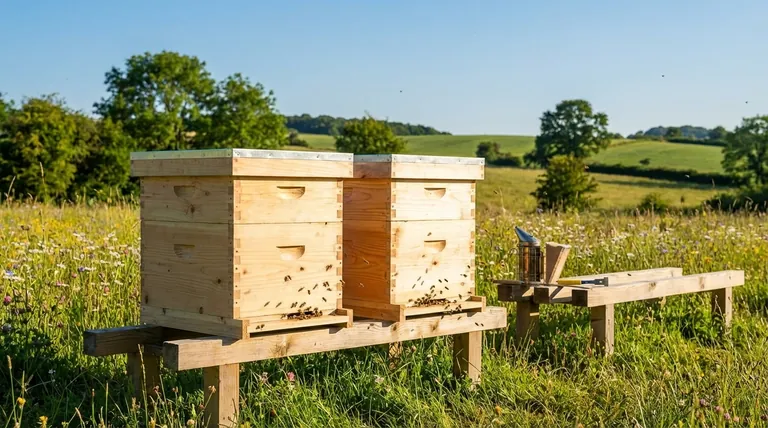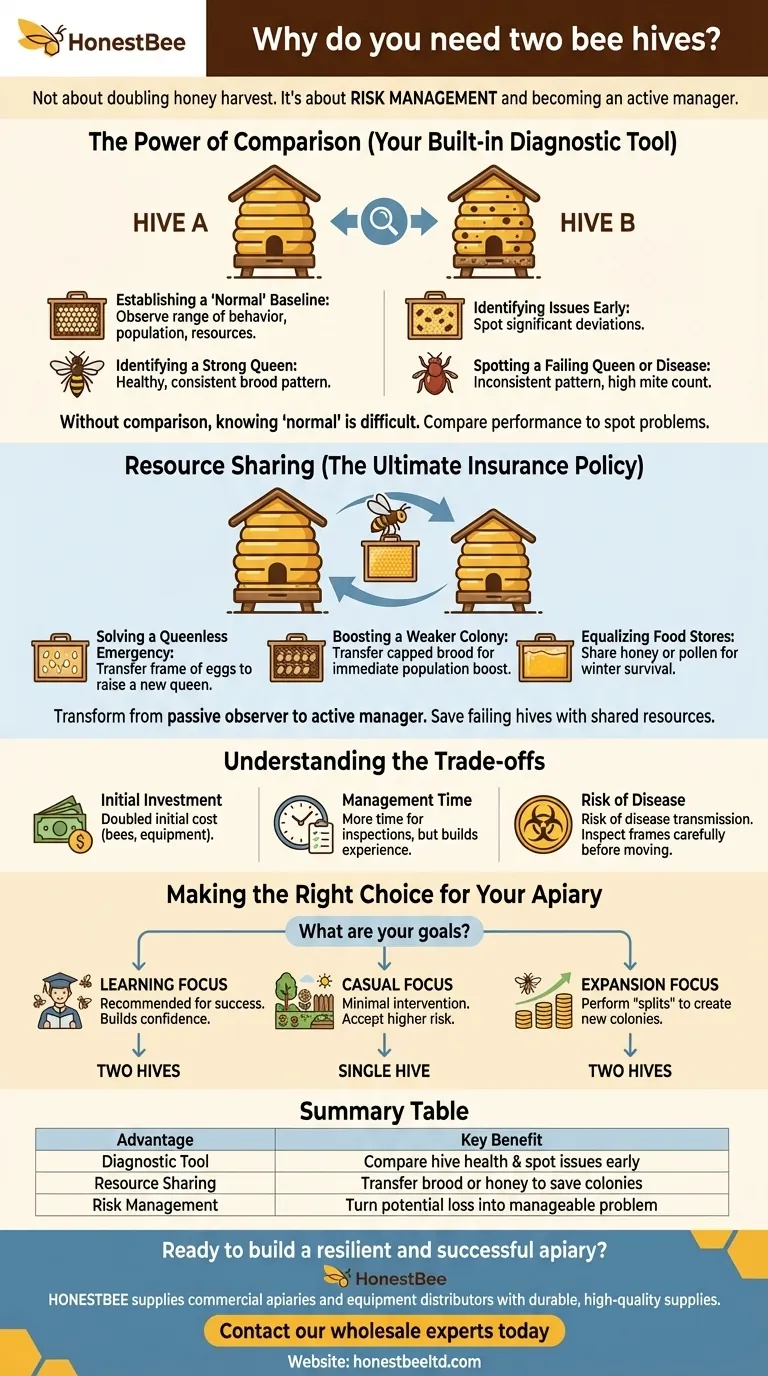While it seems counterintuitive, the recommendation to start with two beehives is not about doubling your honey harvest. It's about providing a critical safety net and management tool that dramatically increases your chances of success. Having a second colony allows you to compare performance to identify problems and, more importantly, share resources to solve them.
The core reason for keeping at least two hives is risk management. A second hive acts as both a diagnostic baseline and a source of essential resources, turning a potentially catastrophic colony failure into a manageable problem.

The Power of Comparison: Your Built-in Diagnostic Tool
Without a point of comparison, it's incredibly difficult for a new beekeeper to know what a "normal" or "healthy" colony looks like. A second hive provides an immediate, real-time baseline.
Establishing a "Normal" Baseline
Each hive has its own personality, but they follow similar seasonal patterns. By observing two hives, you quickly learn the range of normal behavior, population growth, and resource collection in your specific location.
One hive might be slightly more productive or defensive than the other, but significant deviations become obvious. This comparison is your most valuable diagnostic tool.
Identifying a Weak or Failing Queen
Comparing the brood patterns between two hives is the clearest way to spot a queen issue. A healthy queen lays eggs in a tight, consolidated pattern.
If one hive has a spotty, inconsistent brood pattern while the other looks solid, you have a clear, early indicator that one queen is failing and needs to be replaced.
Spotting Disease or Pest Pressure Early
You can also compare hive health. If one colony suddenly has a high mite count, a chalkbrood infection, or other signs of stress while the other does not, you can isolate the issue and treat it before it becomes a crisis.
Resource Sharing: The Ultimate Insurance Policy
The most powerful advantage of a second hive is the ability to move resources between colonies. This transforms you from a passive observer into an active manager who can intervene to save a failing hive.
Solving a Queenless Emergency
This is the single most important reason to have two hives. If a queen unexpectedly dies or fails to return from a mating flight, the colony is doomed unless it has freshly laid eggs to raise a new queen.
A second, healthy hive provides a frame of eggs that you can transfer to the queenless colony. This simple action gives the bees the biological material they need to save themselves.
Boosting a Weaker Colony
Sometimes, one colony will be significantly smaller or slower to build up than its neighbor. You can take a frame of capped brood (developing bees) from the stronger hive and give it to the weaker one.
This infusion of new bees provides an immediate population boost, helping the weaker colony catch up and become self-sufficient.
Equalizing Food Stores
You can also share resources like honey or pollen. If one hive is running low on food stores heading into winter, you can move a frame of honey from the stronger hive to ensure both have enough to survive.
Understanding the Trade-offs
While the benefits are substantial, it's important to acknowledge the practical considerations of managing more than one hive.
The Initial Investment
The most obvious trade-off is cost. Starting with two hives means doubling your initial investment in bees, hive boxes, frames, and other essential equipment.
Increased Management Time
Two hives require more time for inspections and maintenance than one. However, this extra time is often what builds experience and confidence much faster.
Risk of Disease Transmission
It is crucial to be careful when sharing frames between hives. If one colony has a disease, you can easily transmit it to the other. Always inspect frames carefully before moving them.
Making the Right Choice for Your Apiary
Ultimately, the decision comes down to your goals and your approach to managing risk.
- If your primary focus is learning and minimizing risk: Starting with two hives is the standard and most highly recommended path for success.
- If your primary focus is casual backyard pollination with minimal intervention: A single hive can work, but you must accept the higher risk of losing the colony to a problem you cannot solve alone.
- If your primary focus is expanding your apiary: Starting with two allows you to perform "splits" in the future, using your own bees to create new colonies instead of buying them.
Managing two hives transforms you from a simple bee-keeper into a true apiary manager, equipped to solve problems and ensure your colonies thrive.
Summary Table:
| Advantage | Key Benefit |
|---|---|
| Diagnostic Tool | Compare hive health & spot queen issues or disease early. |
| Resource Sharing | Transfer brood or honey to save a failing or weak colony. |
| Risk Management | Turn a potential colony loss into a manageable problem. |
Ready to build a resilient and successful apiary?
Starting with the right equipment is the first step to effective beekeeping. HONESTBEE supplies commercial apiaries and beekeeping equipment distributors with the durable, high-quality supplies needed to manage multiple hives with confidence.
Contact our wholesale experts today to discuss your equipment needs and learn how our products support robust colony management and long-term success.
Visual Guide

Related Products
- Langstroth Bee Hives Bee Keeping Box for Beginners Beekeeping
- Langstroth Honey Bee Box Hive Boxes for Different Depths
- Australian Langstroth Beehive Boxes for Beekeeping Wholesales
- HONESTBEE Professional Long Handled Hive Tool with Precision Cutting Blade
- Professional Insulated Plastic Bee Hives
People Also Ask
- What are the different types of beehive boxes available? Choose the Right Hive for Your Apiary
- How does the ease of access differ between 8-frame and 10-frame hives? Choose the Right Hive for Your Body
- How does the orientation of the hive sides benefit comb construction? Ensure Straight, Movable Combs for Easier Hive Management
- Why might a beginner be advised to start with a Langstroth hive? Unlock a Supportive Beekeeping Ecosystem
- What basic equipment is needed to start beekeeping? Your Essential Guide to a Confident Start



















